Tom's Guide Verdict
The DJI Osmo Action 4 packs some powerful features, and should be more than enough for even hardcore content creators. The problem? A GoPro Hero12 Black won’t cost you that much more.
Pros
- +
Lovely image quality
- +
4K/120fps slow motion
- +
10-bit D-Log color recording
- +
Cool mounting options
- +
Decent internal audio
- +
Good bundle options
Cons
- -
No resolutions over 4K
- -
Battery life mediocre
- -
Could be cheaper versus GoPro
- -
App missing core editing features
Why you can trust Tom's Guide
Starting price: $399
Max video resolution: 4K/120 fps
Sensor: 1/1.3” CMOS
Front screen: 1.4” touchscreen
Rear screen: 2.25” touchscreen
Size: 2.77 x 1.74 x 1.29 inches
Weight: 5.1 ounces
Water resistance: 59ft (18m)
Battery: 1770 mAh
The DJI Osmo Action 4 is the latest iteration of DJI’s action camera. It succeeds the DJI Osmo Action 3, which we happily added to our list of the best action cameras thanks to its affordability, versatile mounting system and, most importantly, solid video quality. The Action 4 builds on its predecessor’s strong points, this time featuring a larger sensor to further improve image quality, and an extra 3 meters of water resistance.
It’s up against some stiff competition, though, primarily in the form of the GoPro Hero12 Black — which tops our list of the best action cameras you can buy, packs impressive video specs on paper, and can be scooped up for a similar price. The Action 4 is also priced closely to the recently released Insta360 Go 3, which is designed to be as lightweight and portable as an action camera can get, at the expense of some professional features.
So, how does the Action 4 stack up against its rivals? And is it the right action camera for you? Find out in our full DJI Osmo Action 4 review.
DJI Osmo Action 4 review: Price & Availability
The DJI Osmo Action 4 was released in August 2023, and comes in a variety of bundle packages. The basic package costs $399 / £379, which nets you a battery, a plastic protective cage and a stick-on mount. This is slightly cheaper than the GoPro Hero12 Black basic accessories bundle, which retails at $449 / £449.
I’d opt for the Adventure combo, which is what I tested, for $499 / £469. This combo adds two extra batteries and a charging case, the protective cage and a selfie stick instead of the stick-on mount. As I’ll cover later, I found the Action 4’s battery life a little disappointing, meaning you’ll definitely want to pick up spares. Two batteries and a charging case, plus a selfie stick, would set you back around $176 / £140 when bought separately, so the adventure combo will save you $77 / £50. You won’t get the stick-on helmet mount, but those can be picked up for just £16 / £15, and battery life should definitely be the priority with this camera.
There are also a range of other combo packages available from DJI, each featuring specialized accessories for specific sports or uses, including road cycling, mountain biking and motorcycling, vlogging, diving, and surfing. It’s a really great range, and can cater for almost everything you’d want to do with the camera. Disappointingly, none come with a Micro SD card, which must be purchased separately.
DJI Osmo Action 4 review: Design
The DJI Osmo Action 4 is lightweight and compact, at 2.77 x 1.74 x 1.29 inches and 5.1 ounces. This makes it slightly smaller than the GoPro Hero12 Black, and very pocketable. It isn’t as compact as the Insta360 Go 3 without its case, and won’t be one for mounting on the peaks of caps or the collars of cats like the Go 3, but the DJI certainly won’t cause your neck any issues when mounted on a helmet.
Get instant access to breaking news, the hottest reviews, great deals and helpful tips.
DJI has paid a lot of attention to the finish, and it shows.
The Action 4 looks very similar to the Hero12 Black, featuring similar proportions, a front and rear screen, as well as a side Q button and a top record button. Build quality is very impressive. The camera feels sturdy and rugged thanks to a metal body, and premium too, with its two glossy screens and the embossed Action 4 logo on front, which houses a color metering sensor. Catches on the battery/card and USB-C port close firmly, buttons provide satisfying haptic feedback, and the lens is supplied with a sturdy filter to protect it, which screws into place using metallic threads. Overall, DJI has paid a lot of attention to the finish, and it shows.

On one side of the camera is the battery and memory card tray. These can both be accessed independently of one another, which I like — on the Insta360 X3, you have to remove the battery to get to the card slot, which can be a little frustrating during use. On the other side is a USB-C port, which allows you to charge the device or hook up accessories.

Along the bottom of the camera is a quick release mounting system, which lets you rapidly swap between different mounting options. The mounting point on the camera itself is horizontal orientation only, but there’s an additional vertical orientation mounting point on the accompanying plastic protective cage for when you want to switch.
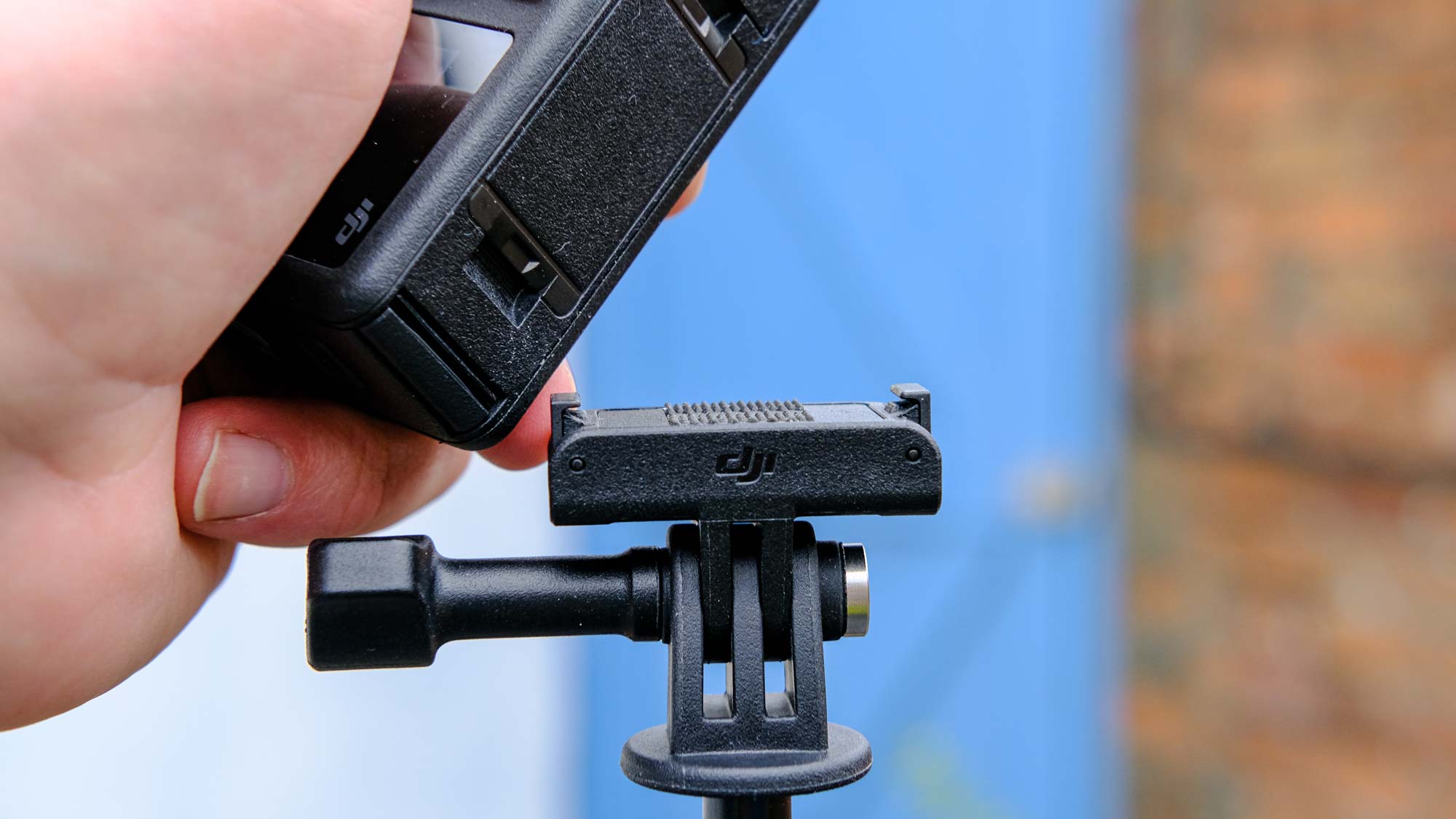
Unfortunately, the quick release mount can be a bit fiddly to use when the Action 4 is in its plastic cage. The cage rim made it difficult for me to get my thumb or finger into the gap between the cage and the fork locking pin to push the quick release button. As a result, I found myself having to yank the Action 4 off its quick mount from one side. This effectively negates the “quick” part of “quick release” for anyone with chunkier fingers and thumbs.
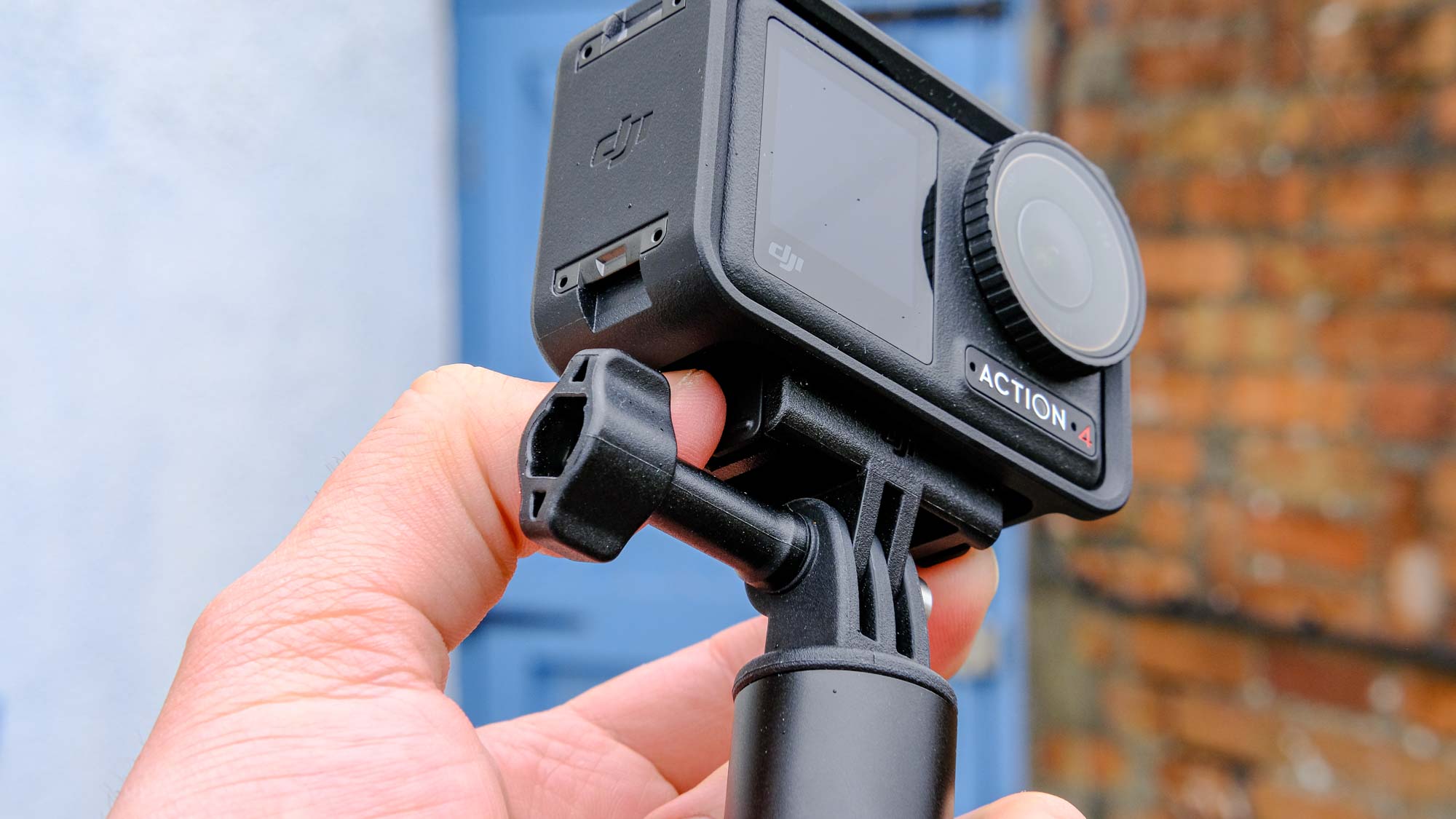
The Action 4 features two touch screens. One on the front, and one on the rear. Both are highly responsive. The rear screen is large and clear, which makes navigating the menu systems (themselves very simple and sensibly laid out) easy.

The front touch screen is super useful if you’re filming yourself, allowing you to quickly check your hair, framing or settings. I barely used it, often turning it off to save battery, but it’ll be super handy for vlogging in particular.
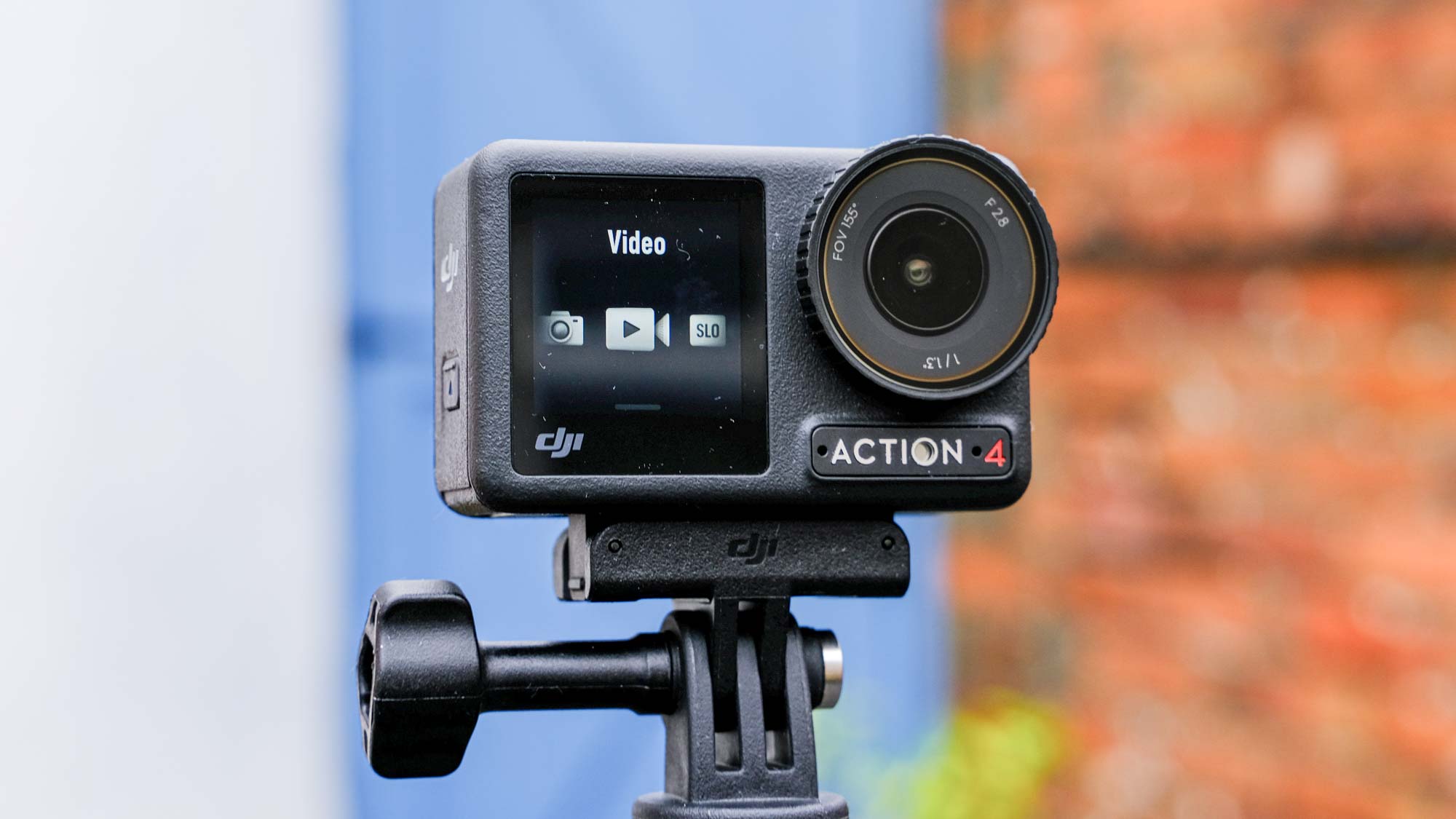
If you are vlogging, the Action 4 offers automatic orientation switching to enable native vertical content for social media stories and shorts. Combined with the screen and the vertical quick release mount on the plastic cage, this makes the Action 4 a really useful tool for quickly switching to vertical content and adding an extra dimension to your content.
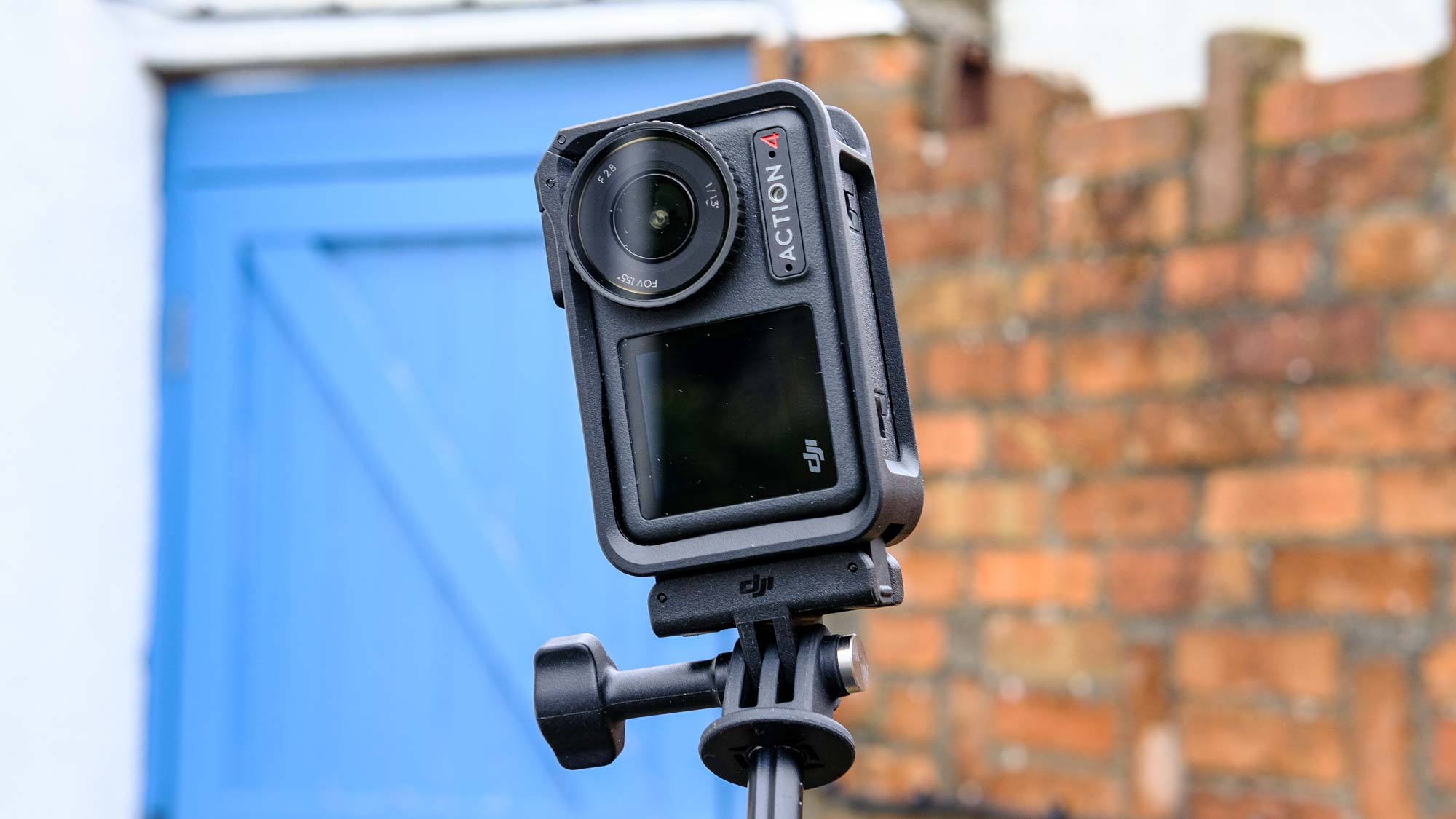
The Action 4 is waterproof down to 18 meters, which is 3 metres deeper than its predecessor and 8 meters deeper than the GoPro Hero12 Black, making the Action 4 the one to choose for watersports or diving footage.
DJI Osmo Action 4 review: Video performance
The Osmo Action 4 produces excellent video footage. There’s a 1/1.3” sensor, a step up from the 1/1.7” sensor in the Action 3, and the 1/1.9” sensor in the GoPro Hero12 Black. This should result in a cleaner image when at higher sensitivity settings, for example in low light.
There’s nothing above 4K as you’d find in the Hero12 Black, but for most casual users, this won’t be a real world issue as 4K is plenty good enough for YouTube or even for professional work. 120fps is on offer at full 4K, which is really nice to have. This means you don’t have to sacrifice resolution for your slow motion scenes.
DJI makes a big deal out of the color temperature sensor in the front of the camera, and claims that this helps the Action 4 produce beautiful, natural colors. I didn’t touch the white balance or color settings and just left the camera to meter and adjust color temperature itself, and the results were impressive. Colors were lovely in the MP4 footage out of camera. On warm sunny days, skies were deep and vivid, with luscious greens and bold, vibrant reds. Footage didn’t feel unnatural, though — in the footage below, shot on a cold morning with sunny intervals, the Action 4 captured the slightly muted tones of the diffused sunlight.
There are only two color modes in-camera: normal and D-Log. While you can apply various filters later down the line when editing footage in the DJI Mimo app, this is a little limiting in terms of creative options as you shoot — Insta360, for example, offers a range of different color filters in its cameras and via its app as you record, so you can see and change your filter while shooting. Anyone who edits their footage, especially for professional usage, will really appreciate the Action 4’s 10-bit D-Log recording, though, which gives extra flexibility in post production with color grading and dynamic range.
There’s a manual mode, but I found the camera exposed and dealt with changing exposures very well in auto. It didn’t blow out highlights and maintained decent detail in shadows.
DJI Osmo Action 4 review: Image stabilization
The Action 4 features electronic image stabilization, which I tested out by taking the camera out for motorcycle rides on bumpy British country roads. The stabilization has two modes: RockSteady and RockSteady+. The first is the basic level of stabilization, which worked well enough at keeping footage smooth when I had the camera mounted in only a slightly bumpy position: mounted to my chest (via DJI’s chest mount harness).
I then tested out the RockSteady+ image stabilization, which essentially adds on electronic stabilization, cropping the image to align frames. I attached the camera to a bracket on my bike’s chassis, low down near the wheel where the footage would be affected more by the bumps in the road. I rode the same route with no stabilization and then with RockSteady+, and the latter was slightly smoother, especially the background of the image, although thanks to the crop, the my bike in the near ground was less smooth than I’d have liked. Stabilization was a weak point in the Action 3, with our review concluding it was just about good enough — it’s more of the same this time around.
There’s also horizon stabilization available when using the DJI Mimo app, which keeps the horizon straight when you’re twisting and leaning. DJI claims that this works during full 360 degree rotations, such as backflipping or loop-the-loops — this’ll be a useful feature for extreme sports that incorporate jumps, like skiing, snowboarding, skateboarding, mountain biking etc.
DJI Osmo Action 4 review: Audio quality
I was impressed by the quality of the Osmo Action 4’s internal microphone. Even in wind-reduction modes, many cameras struggle with the wind noise of motorcycle riding, but the Action 4 did a good job in my testing. Wind noise in the test footage above was present, but not overwhelming.
I was also pleased with the range of audio frequencies the microphone picked up. Small internal microphones sometimes tend to cut out the lower frequencies of motorbike engines, resulting in your bike sounding more like an RC car. The Action 4 picked up the booming bass tones of the bike’s engine, and audio was fairly clean on playback.
Better still, if you’d like really clean audio, the Action 4’s USB-C port can be used to hook up an external microphone. DJI offers a vlogging kit, which includes an external microphone, but we wouldn’t recommend it. The vlogging kit is exorbitantly expensive, costing $728. Sure, DJI makes some vaunted microphones, but you can pick up a high quality USB-C mic from the likes of Rode for around or under $100 separately — do that instead.
DJI Osmo Action 4 review: Apps and features
DJI offers numerous smartphone apps for its devices, which isn’t exactly a good thing. This can be a little confusing to a newcomer, especially as only certain apps work with certain devices. It also makes me a little uncomfortable when I see a variety of different apps from a manufacturer — it feels messy and unstreamlined, and suggests a lack of interoperability and/or backwards compatibility. My unease only worsens when I see many of those apps achieving low user ratings on the Apple App Store, as is the case with DJI’s apps.
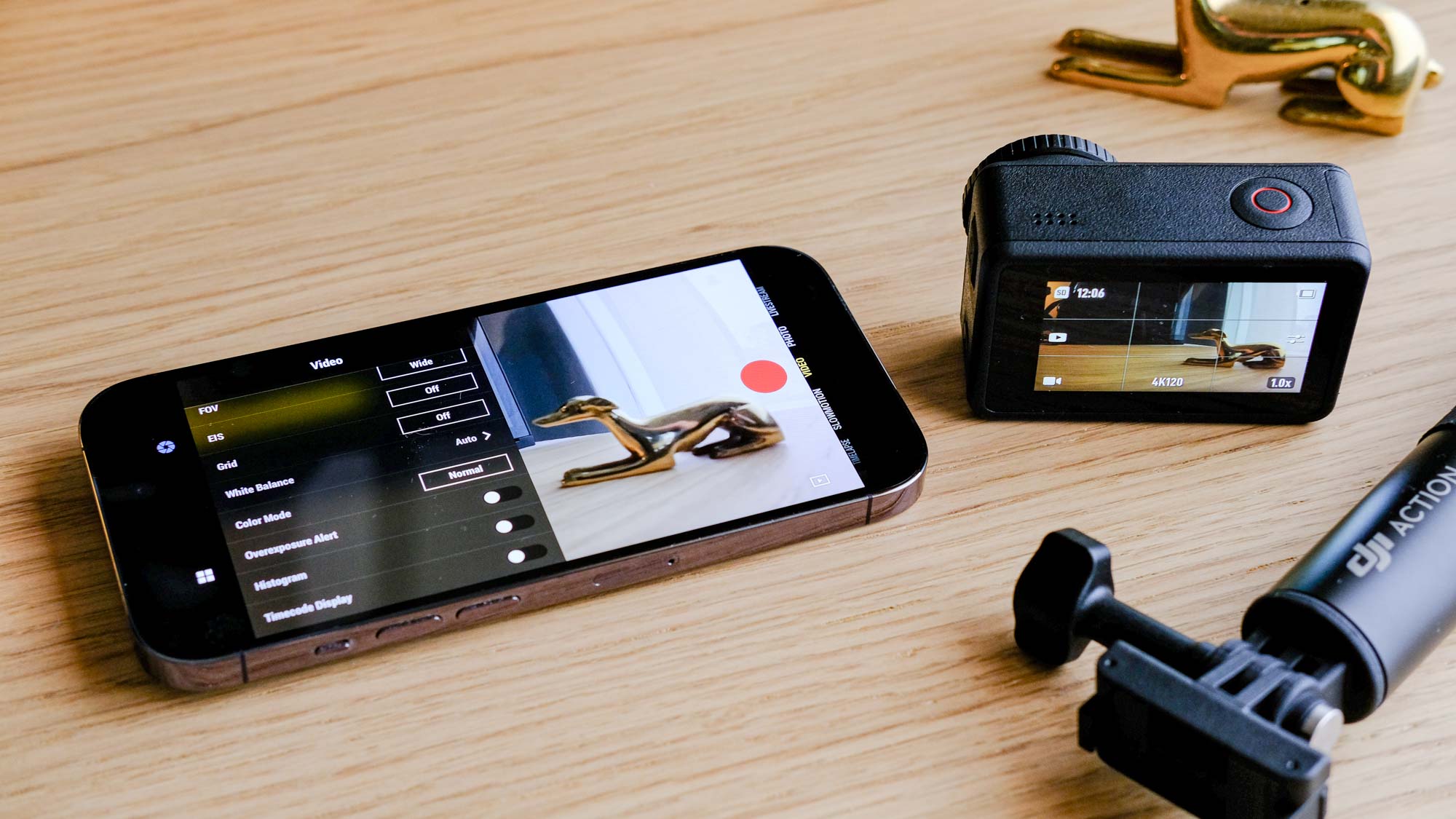
The app that works with the Osmo Action 4 is the DJI Mimo app, which opens up features not available with the standalone camera, such as creative filters and horizon stabilization. The Mimo app is pretty good: it’s easy to navigate; connecting to the camera is quick and painless; and there are a range of controls and shooting parameters in the live view mode, where you can use your phone as a monitor. The editing function is okay: it lets you apply some basic edits like cutting, adjusting speed, adding music and applying filters, but there’s no way of adjusting the exposure of your footage. For the latter, DJI prompts you to download a third party video editing application — that’s two apps where I only want one. On the whole, the Mimo app is OK, but nowhere near as good as rivals, specifically Insta360.
DJI Osmo Action 4 review: Battery life
The Osmo Action 4’s battery life is a little disappointing. In my testing, I was able to record just over 80 minutes of mixed Full HD and 4K footage before the battery died. Around 2/3rds of that was 4K, and everything was shot at 60p.
When I was recording in an indoor environment to test battery life, the Action 4 unfortunately overheated after about 10 minutes, recording at Full HD/60p. Although I was indoors, this is still disappointing to see at such a low resolution. You can obviously get around this by recording while moving at pace — on my motorbike, I experienced no overheating, even at 4K/60p — but this could still be a realistic issue in many other scenarios where there isn’t the wind to cool the camera down, such as walking or vlogging to camera.
For context, the GoPro Hero11 Black also achieved 80 minutes in our testing, but that was filming at its maximum resolution of 5.7K, while the newer GoPro Hero12 Black is also rated for a similar amount of time at 5.7K. Given I was mixing in Full HD footage, I was expecting longer. If you’re out adventuring, 80 minutes isn’t a long time, so we’d definitely advise investing in the spare batteries and charging case that come with the Adventure combo.
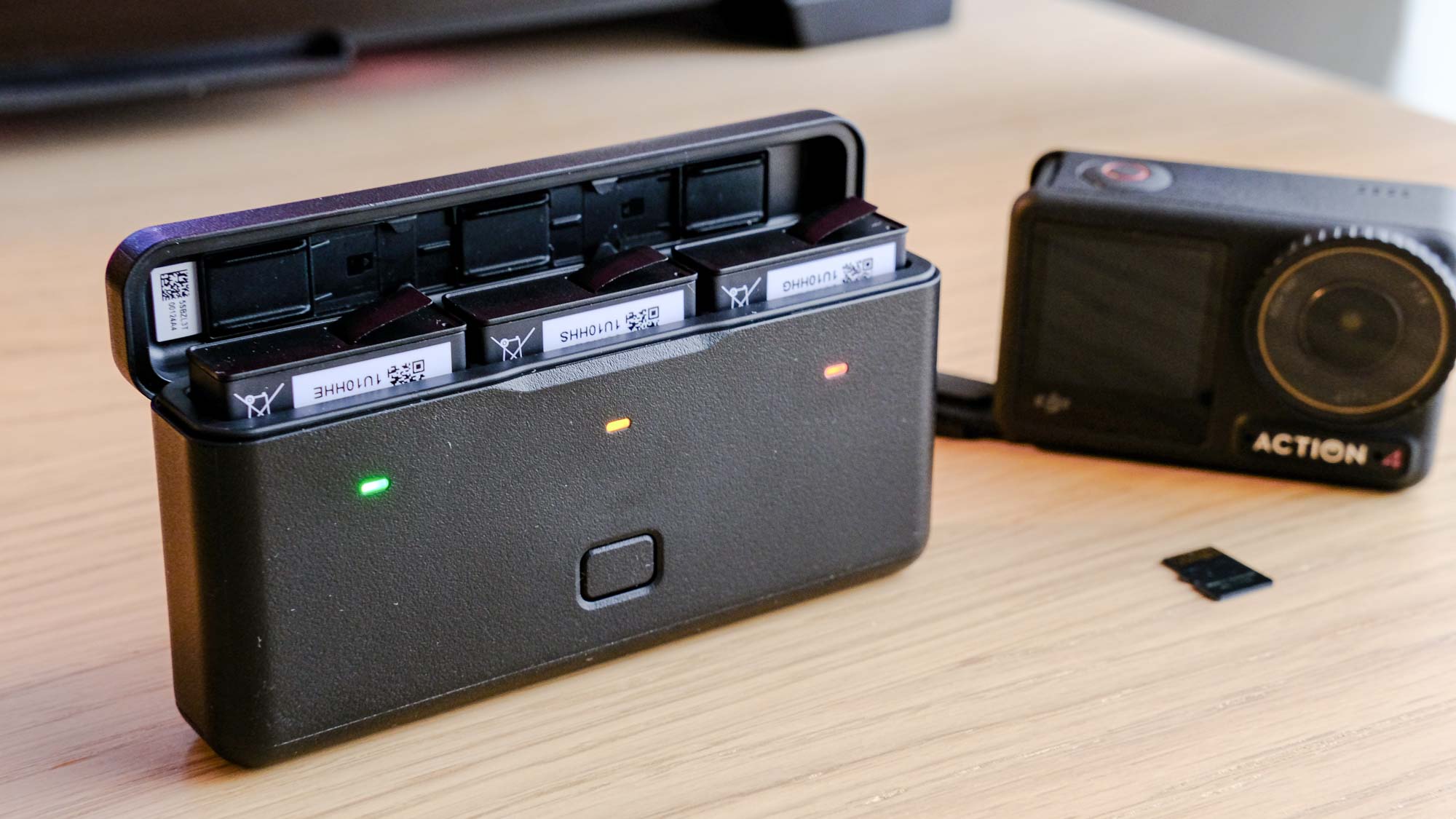
With the adventure Combo, things are different. You’ll have triple the effective battery life — 4 hours, which is a good chunk of time to be recording 4K.
DJI Osmo Action 4 review: Verdict
The DJI Osmo Action 4 offers a lot for action-oriented content creators and vloggers. The video quality is fantastic, internal audio is decent, and there are a range of awesome mounting options. Personally, that’d be enough to sway me into buying the Action 4, as the fundamentals of picture, sound and camera angle are most important to me. If you’re into water sports, the 18M water resistance could well be a clincher, too, as this beats the GoPro Hero12 Black by a whopping 8 meters. There’s also D-Log and 10-bit color, which will appeal to folk who spend time in post-production.
The issues with the Action 4 come in the secondary details. 4K is the maximum resolution — that won’t be a problem to all but the toughest of pixel chasers, but it’s still a con versus the GoPro. The image stabilization is okay, but still not as good as it could or should be. And battery life seems to have gone backwards when compared to its predecessor.
These cons wouldn’t necessarily be an issue if the Action 4 wasn’t so closely priced to the GoPro Hero12 Black, which retails for only $50 more. The benefit of the Action 3 was that it was a budget GoPro alternative — you sacrificed some of the GoPro’s professional features, with the advantage of paying a noticeable chunk less. With the Action 4, you’re making a similar sacrifice, without the benefit of price.

Peter is a Senior Editor at Tom's Guide, heading up the site's Reviews team and Cameras section. As a writer, he covers topics including tech, photography, gaming, hardware, motoring and food & drink. Outside of work, he's an avid photographer, specialising in architectural and portrait photography. When he's not snapping away on his beloved Fujifilm camera, he can usually be found telling everyone about his greyhounds, riding his motorcycle, squeezing as many FPS as possible out of PC games, and perfecting his espresso shots.

